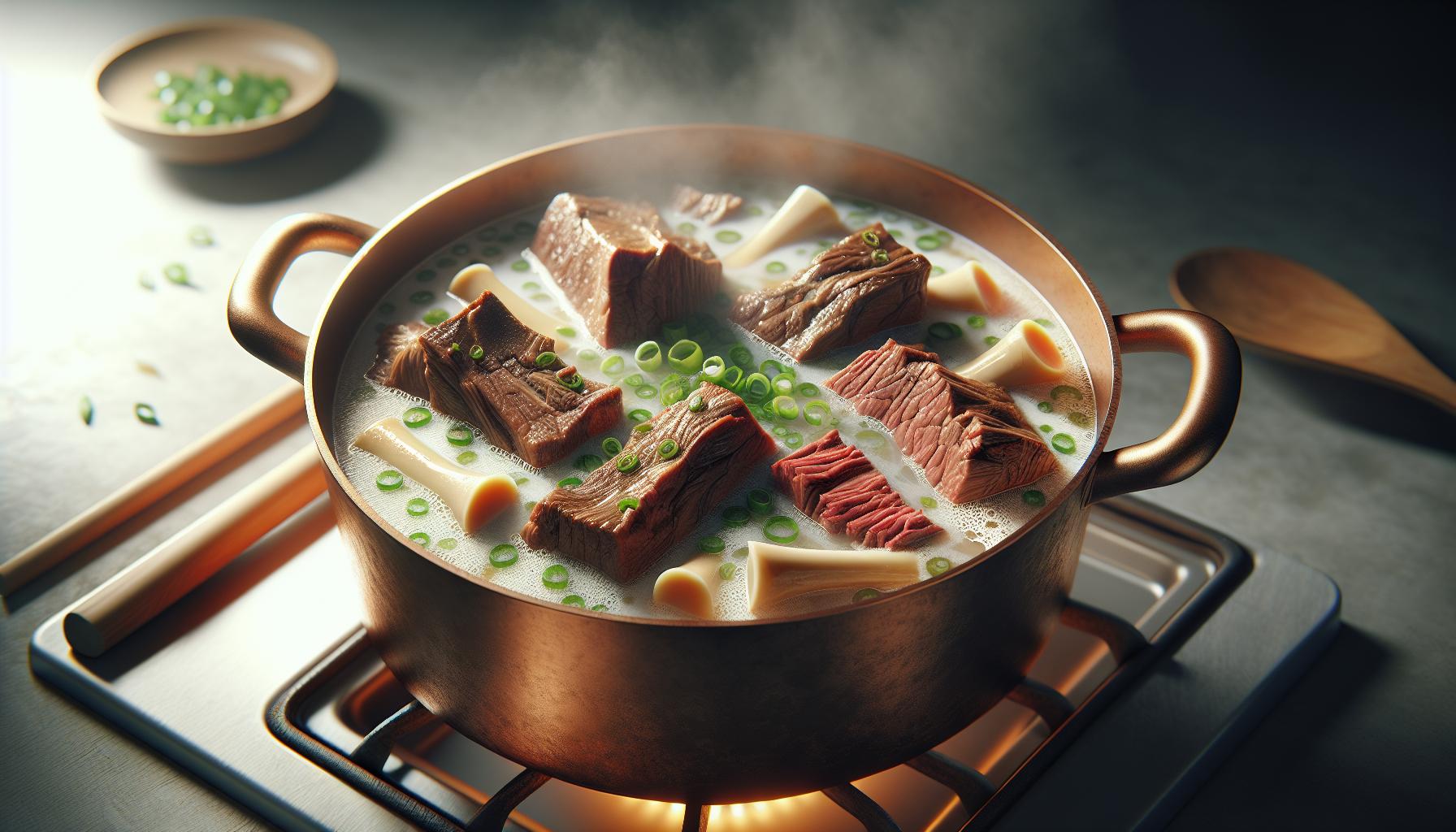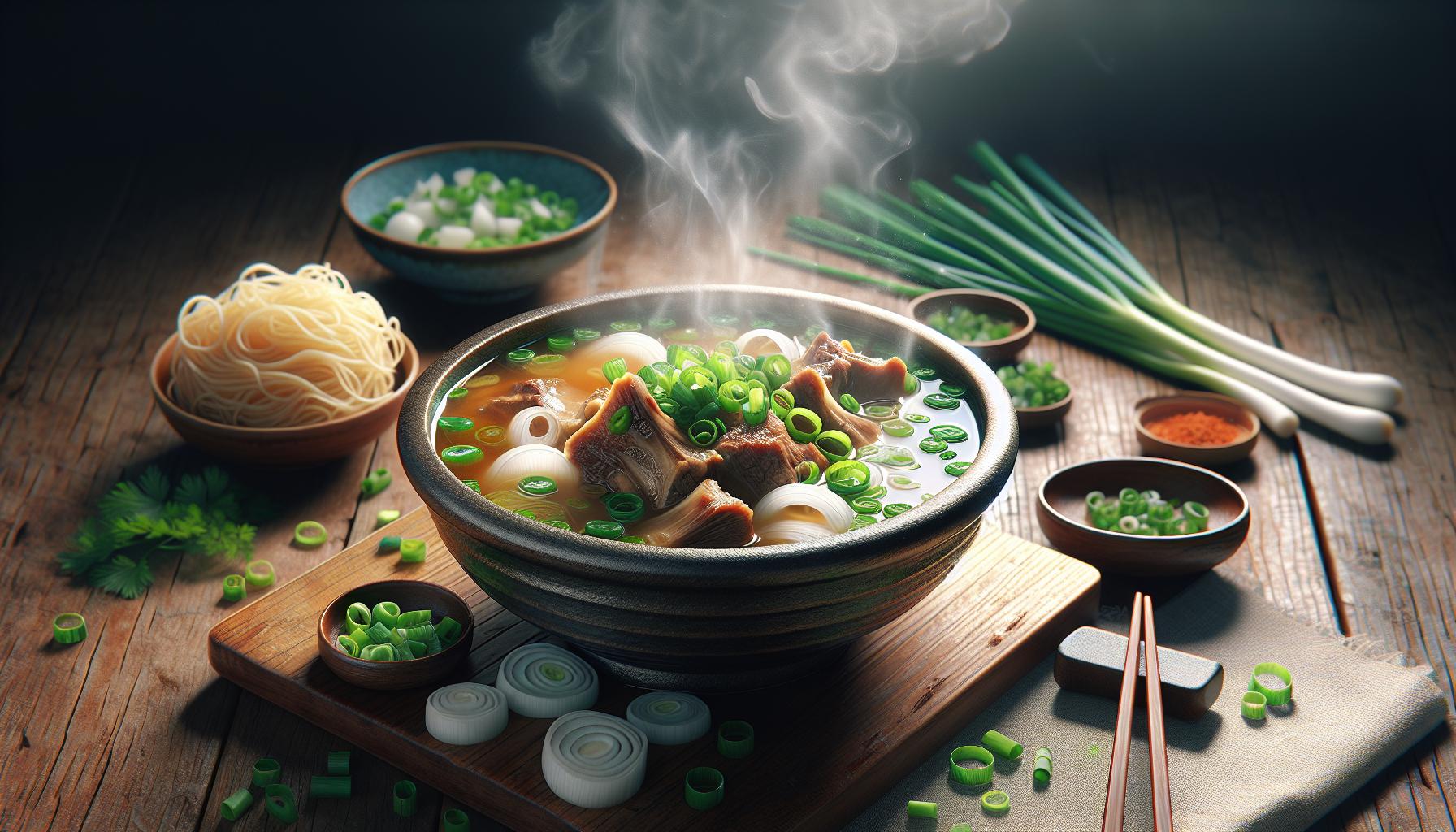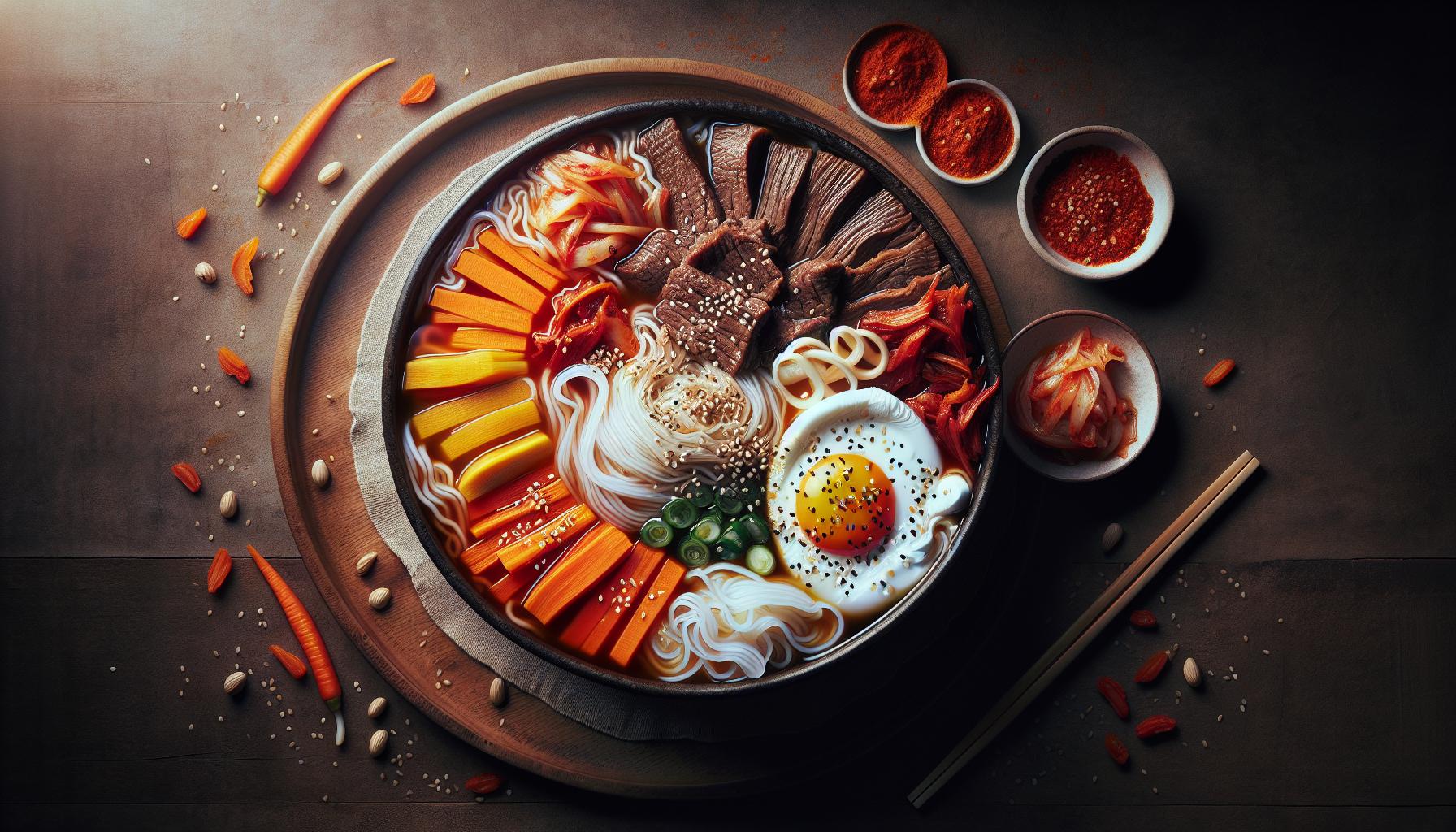Ingredients for Homemade Seolleongtang Beef Bone Soup
To embark on your culinary adventure with Seolleongtang, you need a few key ingredients. Gather them up before you start, so you’re not scrambling mid-cooking phase. Here’s your shopping list:
- 2 lbs beef bones (marrow and knuckle bones are great options for their gelatinous quality)
- 1 lb beef brisket or shank
- 1 whole garlic head
- 2 onions
- Salt and pepper to taste
- Spring onions for garnish
Now let’s add some twists to make this recipe stand out. A bit unconventional, perhaps, but we assure you these extras enhance the flavor profile of your soup:
- 1 Korean radish (mu)
- 3 whole black peppercorns
Pro tip: You could substitute the Korean radish with daikon if need be. Both belong to the same radish family and serve up similar flavors.
Here’s a quick nutritional breakdown of Seolleongtang to ease your health-conscious mind.
| Ingredient | Calories | Carbs | Protein | Fat | Vitamins |
|---|---|---|---|---|---|
| Beef bones | Low | 0g | High | High | A,D |
| Beef brisket | High | 0g | High | High | B’s |
| Garlic head | Low | 9g | 2g | 0g | C, B6 |
| Onions | Low | 10g | 1g | 0g | C |
| Korean radish | Low | 18g | 1g | 0g | C |
Step-by-Step Instructions

When it’s time to get cooking, you’ll find the process for making Homemade Seolleongtang Beef Bone Soup isn’t as daunting as it may seem. Let’s break it down into simple, easy-to-follow steps.
First off, prepare your ingredients. Grab your beef bones and brisket. Try to aim for about 3 lbs of beef bones and 2 lbs of brisket. This may vary depending on your personal taste and how meaty you want your soup to be. If you can’t find Korean radish, go right ahead and substitute it with daikon.
Next, make the bone broth. This is crucial for a rich, hearty soup. Place the bones in a large pot, cover with water, and bring to a boil. Cook for about 10 minutes, then drain and rinse the bones.
Time to get your soup going. Return the bones to the pot, add your brisket, whole peeled onion, several cloves of garlic, and a few pieces of sliced radish. Pour in enough water to cover all the ingredients. Bring your pot to a boil again, then reduce the heat and let it simmer. We’re talking about a long simmer, overnight if you can, for that deep flavor to develop.
In the morning, remove the brisket, let it cool, slice it thin, and refrigerate it. You’re gonna use this as your meat serving later. You can now strain your soup to remove the solids and return it to the pot. Remember to skim off any fat that rises to the top.
Lastly, season and serve your soup. Bring the soup back to a simmer and add salt and pepper to taste. Ladle soup into bowls, add slices of brisket, sprinkle with spring onions, and serve hot.
If you’re interested, here are some notable nutritional facts about Homemade Seolleongtang Beef Bone Soup:
| Calories | Carbs | Fat | Protein |
|---|---|---|---|
| 330 | 4g | 24g | 22g |
Tips for Making the Perfect Seolleongtang

When getting ready to whip up your homemade Seolleongtang beef bone soup, there are a few important tips you can take on board to perfect your cooking game.
Start with Quality Bones
First up, when choosing your beef bones, aim for quality. Head to your local butcher and find the freshest bones. Remember, the quality of your ingredients directly impacts your soup’s richness and depth of flavor.
Simmer Low and Slow
Next, patience is key for a soup with extraordinary flavor. Slow and long simmering extracts all the flavors from the bones, yielding a richly satisfying broth. While simmering overnight might sound excessive, the exquisite flavor pay-off is totally worth it.
Don’t Skimp on Prep
Properly prep your ingredients. Rinse the beef bones thoroughly under cold water. This step eliminates any residual blood or impurities from the bones. Plus, it will help to keep your soup’s color clear and light.
Think Nutritious
Consider the soup’s nutritious values in each step you take. Seolleongtang is a nutrient-packed meal. With every mouthful, you’re getting a decent dose of proteins, fat, and calories. Not to mention, it’s low in carbs! It’s not just a delicious comfort meal; it’s a hearty and hale soup.
The Magic of Garnish
Finally, don’t forget the garnish. A sprinkle of spring onions or a handful of Korean noodles could give your soup depth and a colorful vibrancy. And for those of you gunning for a soul-warming bite, a dash of red pepper flakes can add that extra kick you’re after.
In your quest to create some magic with your homemade Seolleongtang, remember: your ingredients, the time given to simmering, and extra attention to garnish all play crucial roles in creating a perfect soup—not just in flavor, but in nutrition too. Enjoy the process, as much as you’ll relish the spoonfuls. Now, you’re all set to impress your friends and family with your perfect rendition of this Korean classic. Let every pot you cook mark a new milestone in your culinary journey.
Serving and Garnishing Your Seolleongtang

Another crucial stage of preparing Seolleongtang involves the right way of serving and garnishing. It’s all about presentation. The power of garnishing simply cannot be understated.
Plating the Soup
Scoop out a generous amount of your well-cooked soup into a bowl with a ladle. Make sure there are chunks of meat, noodles, and flavorful broth in equal proportions.
Adding Spring Onions
A crucial garnish for your Seolleongtang is of course the bright green spring onions. Finely chop them. Scatter a handful over the bowl with a light hand. You’re eyeing some color contrast, and a punchy sharp taste cutting through the rich beefy flavors.
Sprinkling Red Pepper Flakes
Here’s something you don’t typically find in every Seolleongtang recipe – red pepper flakes. Yes, this is the little secret we promised. These deep red tiny spice bombs add a subtle, lingering heat to every mouthful. It’s a real kick. A good shake of these over your soup will give a us unforgettably warm sensation.
Nutritional Value
We understand you’re not just conscious about taste but also nutrition and we’ve got you covered. Let’s break down the key components in our wholesome bowl of Seolleongtang.
| Nutrient | Average Amount Per Serving |
|---|---|
| Calories | 300 |
| Carbs | 27g |
| Protein | 22g |
| Fat | 13g |
| Vitamins & Minerals | Varies based on ingredients |
The beauty of home cooking lies in this – the control you have over your nutrition intake while not skimping on the taste. Healthy and flavorful – that’s our motto.
Variations and Additions to Customize Your Seolleongtang

Seolleongtang is a versatile dish. It’s not unusual to find an array of variations from kitchen to kitchen. You can put your spin on this soup, and we’re about to share some ways to do it.
Noodles can be an exciting addition! Thinking about something more filling? Add glass noodles (dangmyeon) to your seolleongtang! They’re not only gluten-free but also absorb the broth’s flavor, giving a delightful texture to each mouthful.
For those who enjoy a bit of tang, kimchi is an excellent topping. Its crunchy texture, spiciness, and tangy flavor will surely enhance your soup. Ensure it’s well-fermented kimchi for the best impact!
Have you considered an egg? A poached egg, in particular, with its runny yolk, can add an extra layer of richness to your seolleongtang. Loved for its protein content, it’s both delicious and heartily satisfying.
Then there’s the world of herbs and seasonings. ** Garlic and ginger** can provide a depth of flavor that goes a long way. Don’t forget a sprinkle of sesame seeds! They add a nutty flavor and are packed with nutrients.
For those who need a heat kick, gochugaru (Korean chili flakes) or gochujang (Korean chili paste) could be your ticket. Keep in mind; it’s a matter of taste, so adjust these according to your preference.
Finally, you might want to consider decorative veggies. Julienned carrots, radishes, or cucumbers are all great choices for some added crunch and color. They’ll make your seolleongtang a visual treat!
Conclusion
So there you have it – your very own homemade Seolleongtang beef bone soup. It’s not just about the rich, hearty broth but the endless possibilities for customization. Whether you’re craving a touch of tanginess from kimchi, a hit of spice from Korean chili, or the satisfying crunch of fresh veggies, this soup has got you covered. Don’t forget those glass noodles for a delightful texture contrast or a poached egg to up the richness. It’s all about creating a soup that’s uniquely yours, packed with flavors that cater to your palate. So go ahead, experiment, and savor every spoonful of your personalized Korean classic. Happy cooking!

